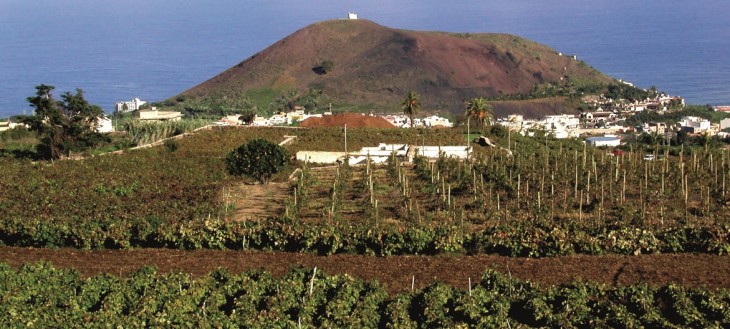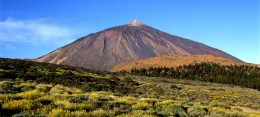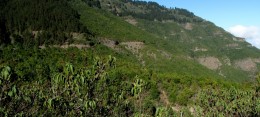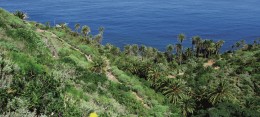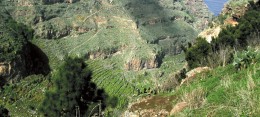The Montaña de Los Frailes [Friars’ Mountain] is a small black or reddish-brown volcanic cone with a 25.71-hectare circular base. It stands out in the Valley of La Orotava as a remarkable landscape feature.
Modern technology techniques have proved it dates back to the 13th century and it was the result of a series of relatively recent eruptions. However, it turns out to be a very active mountain, as regards geomorphology, though steady in terms of relevant volcanic events.
This outstanding landmark in the landscape of the Valley of La Orotava is very important not only for the region, but also for the island, as regards topography and the state of conservation of its crater. Given its location on a rather flat area of the Valley of La Orotava, Friars’ Mountain stands out remarkably, reaching an altitude of over 370 metres.
In addition to this, it’s of great geological and geomorphological interest, considering its structure and the fact that is part of a chain of three volcanic cones that originated at the same time. Their eruptions caused the coastline to stretch further out into the sea in this part of the island.
The main access to the mountain is reached via a secondary road around the complex that takes you to a trail leading to the Hermitage of the Cross.
On the top of the cone, there’s a site that evidences its shepherding use from the times of the aborigines until recently.
This place has also served cultural and agricultural purposes, which explains the presence of several crops and a little hermitage on the top of the mountain.
The structure of the hermitage is that typical of the Canarian rural areas: a single building with a rectangular layout, with stone moulding on the corners and a lintel on the main entrance. Every May 3rd, local people gather there to celebrate a procession in remembrance of an old tradition to ask for rain, to avoid plagues and to show gratitude for good crops.
The old building at the foot of the mountain is of great ethnographic value and has been recently restored to house parts of the El Monasterio Restaurant complex. A number of valuable historic elements can be found in the premises, such as the wine press, the old path, the farmers’s house and the wine cellar. The place also offers stunning views of the valley.
- ¿Dónde está?
- ¿Qué hay alrededor?
- Artículos relacionados
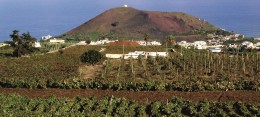 Monumento Natural de La Montaña de Los Frailes
Monumento Natural de La Montaña de Los Frailes Naturdenkmal Montaña de Los Frailes
Naturdenkmal Montaña de Los Frailes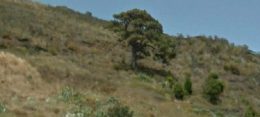 Pino solitario de la Montaña de los Frailesa 0,15 km
Pino solitario de la Montaña de los Frailesa 0,15 km Die einsame Kanarische Kiefer von „Montaña de los Frailes“a 0,15 km
Die einsame Kanarische Kiefer von „Montaña de los Frailes“a 0,15 km The lonely Canary Pine of “Montaña de los Frailes”a 0,15 km
The lonely Canary Pine of “Montaña de los Frailes”a 0,15 km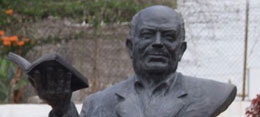 Homenaje a Juan Marrero Gonzáleza 0,27 km
Homenaje a Juan Marrero Gonzáleza 0,27 km Tribut an Juan Marrero Gonzáleza 0,27 km
Tribut an Juan Marrero Gonzáleza 0,27 km Homage to Juan Marrero Gonzáleza 0,27 km
Homage to Juan Marrero Gonzáleza 0,27 km Mesón El Monasterioa 0,29 km
Mesón El Monasterioa 0,29 km Mesón El Monasterioa 0,29 km
Mesón El Monasterioa 0,29 km Mesón El Monasterioa 0,29 km
Mesón El Monasterioa 0,29 km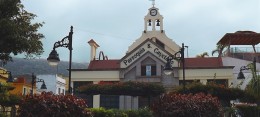 Iglesia de San Cayetanoa 0,36 km
Iglesia de San Cayetanoa 0,36 km


